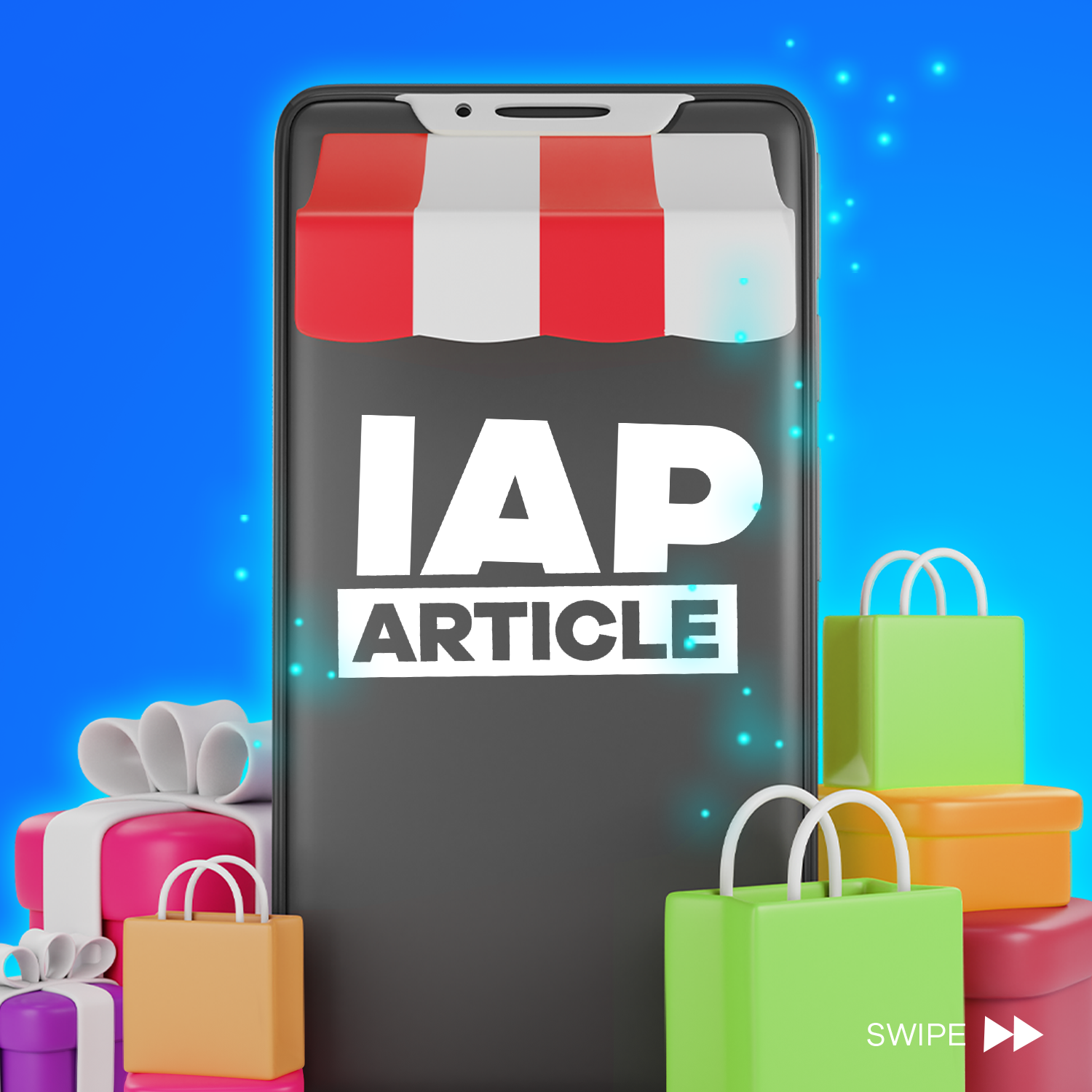
Timothée Bruneau – Dec 04, 2023
In the rapidly evolving landscape of mobile apps, developers are constantly seeking new ways to monetize their creations. One of the most popular and effective methods is through In-App Purchases (IAPs). This article will explore the world of IAPs, their significance in the app industry, their impact on users, and some best practices for developers.
What are In-App Purchases (IAPs)?
In-App Purchases (IAPs) are a form of microtransactions within mobile applications, allowing users to buy virtual goods or services directly within the app. These purchases enhance the user experience, unlock premium content, and help developers generate revenue. Common examples of IAPs include buying in-game currency, ad removal, premium features, and content packs.
The Significance of IAPs:
In-App Purchases (IAPs) have revolutionized the way developers make money from mobile apps. They offer several key advantages:
Revenue Generation: In-App Purchases (IAPs) provide a consistent revenue stream for app developers. As users make small, frequent purchases, the financial success of the app becomes more predictable and sustainable.
Enhanced User Experience: In-App Purchases (IAPs) can significantly improve the user experience by offering the option to remove ads, access premium content, or progress faster in a game. Users appreciate the flexibility to choose how they want to engage with the app.
App Monetization Model: In-App Purchases (IAPs) allow developers to offer their apps for free or at a low upfront cost, making it easier to attract a wider user base. This freemium model can lead to higher download numbers and more engaged users.
The Four Types of In-App Purchases (IAPs) and How to Use Them:
- Consumables:
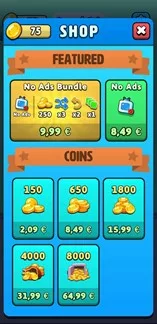
(Coin/money)
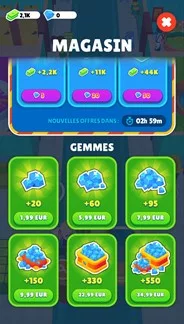
(Gems/hard currency)
Consumables are virtual items that users can purchase and use up within the app. Once consumed, they typically need to be repurchased. Common examples of consumables include in-game currency, power-ups, or virtual goods.
Tips for Using Consumables:
- Give Each Consumable a Proper Onboarding: Ensure users understand the purpose and usage of each consumable before introducing new ones. A well-informed user is more likely to make a purchase.
- Offer Discounts or Bundles: Consider bundling consumables or offering discounts when users purchase them in larger quantities, encouraging higher spending.
- Offer Extra Gameplay: Instead of limiting consumption, focus on providing consumables that enhance the overall gameplay, offering users more chances, moves, or resources.
- Non-Consumables:

(Battle Pass)
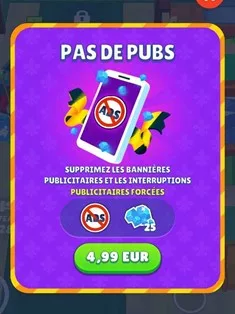
(No ads)
Non-consumables are In-App Purchases (IAPs) that users buy once and retain permanently. They include items such as ad removal, additional levels, or permanent character skins in games.
Tips for Using Non-Consumables:
- Provide Value and Longevity: Ensure that non-consumable items provide substantial value and enhance the user experience over the long term.
- Promote Exclusive Access: Market non-consumables as exclusive and desirable items to motivate users to make the purchase.
- Balance Free and Paid Content: Maintain a balance between free and non-consumable paid content to appeal to a wide range of users.
- Renewable Subscriptions:

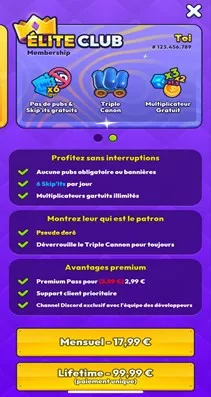
Renewable subscriptions grant users access to premium content or features for a set period (e.g., monthly or annually). Examples include premium content in news apps, ad-free experiences, or extra cloud storage in productivity apps.
Tips for Using Renewable Subscriptions:
- Offer a Free Trial: Attract users by providing a limited-time free trial to showcase the benefits of a subscription.
- Clearly Communicate Value: Clearly outline the value users will receive with the subscription to justify the recurring cost.
- Regularly Update Content: Continuously add new premium content or features to keep subscribers engaged and subscribed.
- Non-Renewable Subscriptions:


Non-renewable subscriptions provide access to premium content or features for a fixed duration, typically a one-time purchase for a limited period.
Tips for Using Non-Renewable Subscriptions:
- Highlight Limited-Time Access: Emphasize that this subscription is a one-time purchase for a specific period to create a sense of urgency.
- Price Competitively: Offer non-renewable subscriptions at an attractive price point to make them appealing to a broad user base.
- Provide a Taste of Premium Content: Allow users to experience some premium content before prompting them to purchase a non-renewable subscription.
The Impact on Users:
While In-App Purchases (IAPs) offer substantial benefits to developers, they also raise important considerations for users:
- The Freemium Trap: Some users may feel pressured to make purchases to progress in a game or access critical features. Developers need to strike a balance to avoid alienating non-paying users.
- Transparency: It is essential for developers to be transparent about the costs of In-App Purchases (IAPs) and ensure users understand what they are purchasing. Clear pricing and descriptions can prevent unexpected charges and maintain trust.
- Customer Support: Providing prompt and helpful customer support for any IAP-related issues can enhance the user experience and foster loyalty.
Best Practices for Developers:
Successful implementation of In-App Purchases (IAPs) requires careful planning and execution. Here are some best practices for developers:
- Value for Money: Ensure that In-App Purchases (IAPs) offer tangible value to users. Make purchases meaningful and impactful on the user experience.
- Fair Monetization: Avoid creating a pay-to-win environment, which can drive away users. Balance gameplay for both paying and non-paying users.
- A Clear Pricing Structure: Provide transparent pricing for In-App Purchases (IAPs), and avoid any hidden fees or misleading advertising.
- Regular Updates: Continue to add new content and features to encourage ongoing engagement and purchases.
- Test and Optimize: Monitor user behavior, gather feedback, and refine your IAP strategy based on user preferences and trends.
- Keep Your Shop Simple, Organized, and Intuitive: Streamline the in-app purchase process by presenting it in a simple and organized manner. An intuitive interface enhances the user experience, making it more likely for users to explore and make purchases.
Conclusion
In-App Purchases (IAPs) have become a cornerstone of the mobile app ecosystem. When implemented thoughtfully, they benefit both developers and users, contributing to a thriving app industry. By following best practices and maintaining transparency, developers can create a win-win situation where users get the value they desire, and developers generate revenue for their hard work. Understanding the nuances of the four types of In-App Purchases (IAPs) and applying effective strategies can lead to success in the competitive world of mobile apps.


